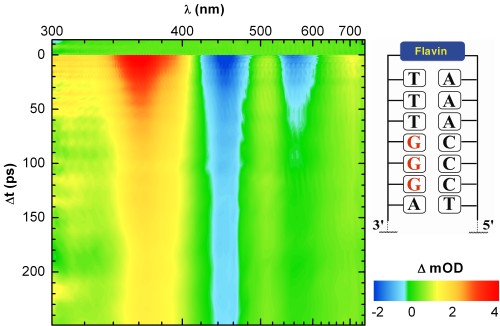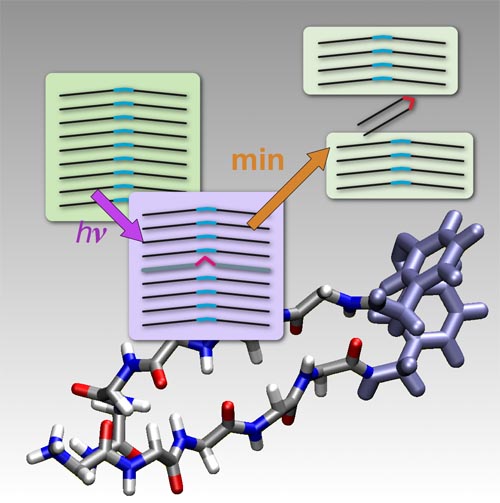Research Area A
Publications 2011
16-Mar-2011
6,7-Dimethyl-8-ribityllumazine serves as fluorophore in lumazine proteins (LumP) of luminescent bacteria. The molecule exhibits several characteristic vibrational absorption bands between 1300 and 1750 cm−1 in its electronic ground state. The IR-absorption pattern of the singlet excited ππ* state was monitored via ultrafast infrared spectroscopy after ... READ MORE
03-Mar-2011
Femtosecond IR-pump-IR-probe experiments with independently tunable pulses are used to monitor the ultrafast response of selected IR absorption bands to vibrational excitation of other modes of Fmoc-nitrophenylalanine. The absorptions of both NO2-bands change rapidly within <2 ps upon excitation of other vibrational modes. The results point to considerable ... READ MORE
18-Feb-2011

Quantum yields of up to 14 % for the formation of a long-lived, charge-separated state can be achieved in flavin-capped DNA hairpins. The excited flavin state is quenched by electron-transfer processes from adjacent DNA bases. The introduction of multiple (dG:dC) base pairs leads to efficient hole trapping that competes with the charge recombination through ... READ MORE
19-Jan-2011
Starting from an appropriate 6-chloro-2-TMS-purine derivative, a regioselective functionalization of the purine scaffold was achieved successively at positions 8, 6, and 2 via zinc and magnesium intermediates which were generated either by a direct zincation with TMPZnCl 3 LiCl or by an I/Mg exchange with iPrMgCl. ... READ MORE
09-Jan-2011
The endoplasmic reticulum is the site of folding, assembly and quality control for proteins of the secretory pathway. The ATP-regulated Hsp70 chaperone BiP (heavy chain–binding protein), together with cochaperones, has important roles in all of these processes. The functional cycle of Hsp70s is determined by conformational transitions that are required for ... READ MORE
27-Dec-2010

Self-assembly and aggregation of proteins or peptides into amyloid fibrils have attracted wide attention due to their high relevance for a variety of amyloid-related diseases.[1–3] Furthermore, amyloids show interesting material properties which make them ideal candidates for the production of nanostructures and molecular nanobiomaterials, where building blocks ... READ MORE
16-Nov-2010
To investigate the parameters and rates that determine excess-electron transfer processes in DNA duplexes, we developed a DNA double-duplex system containing a reduced and deprotonated flavin donor at the junction of two duplexes with either the same or different electron acceptors in the individual duplex substructures. This model system allows us to bring the two ... READ MORE
Ultrafast spectroscopy in the visible and mid-infrared is used to study the reaction dynamics of two light-triggered model peptides containing an azobenzene derivative as a switching element. One model peptide, the AzoTrpZip2, forms a β-hairpin structure in the cis form of the chromophore. This peptide is compared to the core structure consisting of the chromophore ... READ MORE
The mechanism of formation of Dewar lesions (see scheme) has been investigated by using femtosecond IR spectroscopy and ab initio calculations of the exited state. The 4π electrocyclization is rather slow, occurs with an unusual high quantum yield, and—surprisingly—is controlled by the phosphate backbone. ... READ MORE
The photophysics of 1-methyl-2(1H)-pyrimidinone (1MP) dissolved in water is investigated by steady-state and time-resolved fluorescence, UV/Vis absorption, and IR spectroscopy. In the experiments, excitation light is tuned to the lowest-energy absorption band of 1MP peaking at 302 nm. At room temperature (291 K) its fluorescence lifetime amounts to 450 ps. With ... READ MORE


